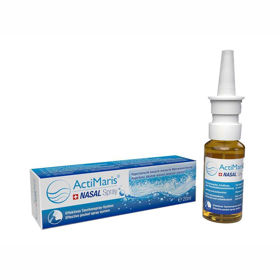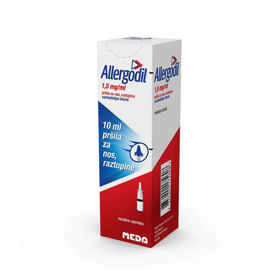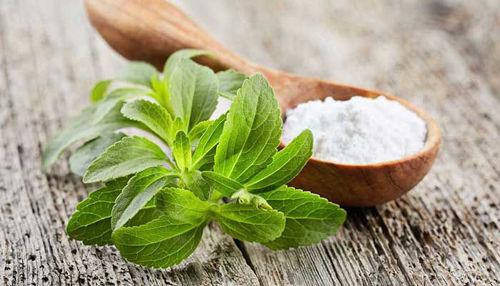Zamašen nos je simptom, ki se pojavi, ko se nosna votlina in sinusi vnamejo - posledično se nabira sluz, tkiva nabreknejo, kar blokira pretok zraka skozi nosno votlino. Stanje zamašenega nosu je sila pogosto in je ponavadi posledica prehlada, alergije ali vnetji.
ZAMAŠEN NOS: Kaj je zamašen nos? | Simptomi | Posvet z zdravnikom | Vzroki zamašenosti | Nasveti za odmašitev | ČIŠČENJE SINUSOV | Zdravila | Preprečevanje | Vprašanja in odgovori | Viri/reference
Zamašen nos se pojavi, ko nosna in sosednja tkiva ter krvne žile otečejo zaradi odvečne tekočine, kar povzroči občutek "zamašenosti". Draženje sproži verižno reakcijo vnetja, otekanja in nastajanja sluzi, kar oteži vdihavanje zraka skozi nos. Zamašen nos lahko vključuje ali ne vključuje izcedek iz nosu. Zamašen nos je običajno le nadloga za starejše otroke in odrasle.
Toda zamašenost nosu je lahko sila neprijetna, lahko pa je celo zelo resna za otroke, katerih spanje moti zamašen nos, ali za dojenčke, ki imajo zaradi tega težave pri hranjenju. Zamašenost nosu običajno izgine po nekaj dneh, vendar je trajno zamašen nos, ki traja en teden ali več, lahko znak okužbe. Če se zamašen nos ne zdravi, lahko povzroči celo sinusitis, nosne polipe, zell pogosto pa tudi okužbe srednjega ušesa.
Video vsebina: zakaj ni mogoče dihati skozi nos, ko si prehlajen?

V splošnem zamašen nos ni nevaren za zdravje in je običajno posledica manjše okužbe ali težav z morebitnimi alergijami. Če pa zamašen nos spremljajo tudi drugi simptomi, kot so povišana telesna temperatura, bolečine v predelu obraza, neprijeten pritisk v sinusih in/ali težko dihanje, je to lahko znak resnejšega stanja, ki ga mora oceniti zdravnik.
Simptomi zamašenega nosu
Simptomi zamašenega nosu vključujejo najpogosteje neprijeten izcedek iz nosu, pogosto je tudi kihanje in oteženo dihanje, ki ima lakho za posledico tudi glavobol.
Manj pogosti simptomi, ki ste jih v primeru zamašenosti nosa že doživeli so sledeči:
- bolečine v predelu obraza,
- glavoboli,
- vnetje grla, ki predstavlja zelo pogosto posledico zamašenosti nosa
Slika: zamašen nos in simptomi.

- pomanjkanje vonja in okusa
- občutek nenehne utrujenosti in
- nihanje razpoloženja.
Zdravniški posvet
Čeprav je zamašen nos običajno povzročen zaradi prehlada, alergij ali sinusnih vnetij in ga lahko zdravimo z zdravili, domačimi zdravili ali izpiranjem nosu, lahko od časa do časa zamašenost nosu nakazuje na resnejšo bolezen.
Še posebej, če zamašenost nosu traja resnično dolgo je posvet z zdravnikom prava ideja. K osebnem zdravniku se odpravite, če se simptomi zamašenega nosu ne odpravijo v nekaj dneh ali pa se celo se pojavijo drugi simptomi, kot denimo vročina, bolečine obraza, pritisk v sinusih in posledična bolečina ali težave pri dihanju.
Glavni vzroki za zamašen nos
Manjše bolezni so najpogostejši vzroki zamašenega nosu. Na primer, prehlad, gripa in vnetje sinusov lahko zelo pogosto povzročijo zamašenost nosa. Z boleznijo povezana kongestija se običajno izboljša v 1-2 tednih.
Video vsebina: 7 najpogostejših vzrokov nosne obstrukcije

Če traja dlje kot 10-14 dni, je to pogosto simptom druge ali resnejše zdravstvene težave.
Nekatere razlage za dolgotrajno zamašenost nosu so lahko:
- alergije
- seneni nahod
- nekancerozne tvorbe, imenovane nosni polipi, ali benigni tumorji v nosnih poteh
- sinonazalni tumorji, čeprav je to redko
- kemične izpostavljenosti
- okoljske dražilne snovi
Slika: neprijetno zamašen nos.

- dolgotrajna okužba sinusov, znano kot kronični sinusitis
- anatomski vzroki, kot je ukrivljen septum, hipertrofija concha bullosa
- povečani adenoidi
- gastroezofagealna refluksna bolezen, zlasti pri dojenčkih
Zamašen nos se lahko pojavi tudi med nosečnostjo, običajno ob koncu prvega tromesečja. Hormonska nihanja in povečana oskrba s krvjo, ki se pojavi med nosečnostjo, lahko povzročijo prav nosno kongestijo. Te predvsem hormonske spremembe lahko prizadanejo nosne membrane in povzročijo njihovo vnetje, suhost ali krvavitev.
Nasveti za odmašitev nosa
V nadaljevanju predstavljamo nekaj koristnih nasvetov, ki vam bodo v pomoč pri odpravljanju težave zamašenega nosu.
Uporabite vlažilec zraka
Vlažilec zraka je lahko hiter in enostaven način za zmanjšanje bolečine in drugih neprijetnosti v sinusih, saj pomaga pri lajšanju zamašenega nosu. Vlažilec zraka pretvori vodo v vlago, ki počasi napolni zrak in poveča vlažnost v prostoru.
Čiščenje sinusov
Čiščenje sinusov je sila enostaven ter zelo preprost postopek, ki ga lahko opravljate doma. Vključuje uporabo fiziološke raztopine za izpiranje nosne sluzi in drugih dražilnih snovi, ki se pogosto nahajajo v nosni votlini ter sinusuh.
Postopek čiščenja sinusov naj bo sledeč:
1. Začnite s pripravo fiziološke raztopine. Že pripravljeno fiziološko raztopino lahko kupite v lekarni (tudi na spletni strani) ali pa naredite fiziološko raztopino kar doma - za nasvet glede priprave poprostie farmacevta.
2. Za izpiranje nosne votline uporabite neti posodico oziroma lonček ali drugo za izpiranje nosu primerno posodico.
3. Nagnite se nad kopalniški umivalnik in nagnite glavo na eno stran. Postavite dulec vsebnika v zgornjo nosnico.
4. Nežno vlijte fiziološko raztopino v zgornjo nosnico. Fiziološka raztopina bo tekla skozi vaše sinuse in ven iz druge nosnice.
Video vsebina: Neti posodica za začetnike. Kako se uporablja?

5. Ko je vsebnik prazen, nežno izpihnite nos, da odstranite preostalo sluz.
6. Postopek ponovite še na drugi strani.
7. Neti posodico sperite s čisto vodo in pustite, da se posuši na zraku.
8. Morebitno preostalo fiziološko raztopino zavrzite.
9. Za dodatno olajšanje lahko po potrebi uporabite vlažilec zraka
POSEBNO OPOZORILO: NIKOLI NE UPORABLJAJTE SAMO VODE IZ PIPE, pač pa jo nujno kombinirajte s solmi za pripravo raztopine za izpiranje. Še bolje pa je, da uporabite prečiščeno vodo, ki jo kupite v lekarni, kateri dodate omenjene soli. Možna je tudi uporaba le izotonične raztopine, ki jo prav tako dobite v lekarni.
Vdihavanje vlažnejšega zraka lahko pomiri razdražena tkiva in otekle krvne žile v nosu in sinusih. Nekateri ljudje trdijo, da lahko ogret, navlažen zrak pomaga tudi pri boljšem odvajanju zastoja sluzi - to je še posebej dobro razvidno v primeru prhanja z vročo vodo. Če imate simptome zamašenega nosu, vam morda koristi pogostejše toplo prhanje ali pa namestitev vlažilnikov zraka po hiši ali pisarni.
Prhanje - tuširanje
Ste že kdaj imeli zamašen nos in ste ugotovili, da lahko veliko bolje dihate po vročem tušu? Morda obstaja dober razlog za to. Para iz prhe lahko pomaga redčiti sluz v nosu in zmanjšati morebitno vnetje. Prhanje z vročo vodo ponavadi pomaga, da se vaše dihanje vsaj za nekaj časa normalizira.
Enak učinek lahko dosežete z vdihavanjem pare:
- Pogrejte vodo v loncu do vretja.
- Ko je temperatura primerna, si čez glavo pokrijte brisačo in glavo položite nad posodo z vodo.
- Pustite, da se para ustvari, in globoko vdihnite.
- Pazite, da si zaradi vroče vode ali pare ne opečete obraza.
Pogosta hidracija
Ostanite hidrirani in pijte veliko tekočine.
Pomembno je, da pijete veliko tekočine, če sumite, da ste prehlajeni ali imate simptome gripe. Vzdrževanje optimalne ravni hidracije lahko pomaga redčiti sluz v nosnih poteh, potiskati sluz iz nosu in zmanjšati pritisk v sinusih. Manj pritiska pomeni manj vnetja in draženja. Če imate tudi vneto grlo, vam lahko tople tekočine, kot je čaj olajšajo nelagodje v grlu.
Razpršilo s fiziološko raztopino
Naredite pri hidraciji še korak dlje s fiziološko raztopino (raztopina slane vode). Uporaba nosnega fiziološkega razpršila poveča vlažnost v vaših nosnicah, nekatera fiziološka razpršila pa vključujejo tudi dekongestiv. Pogovorite se s svojim zdravnikom, preden začnete uporabljati fiziološke razpršila z dekongestivi.
Uporabite topel obkladek
Topel obkladek lahko pomaga ublažiti nekatere simptome zamašenega nosu tako, da odpre nosne poti od zunaj. Za topel obkladek najprej namočite brisačo v toplo vodo. Nato iz brisače iztisnite vodo, jo zložite in položite na nos in čelo. Toplota lahko olajša bolečino in pomaga pri lajšanju vnetja v nosnici. To ponavljajte tako pogosto, kot je potrebno.
Uporaba zdravil?
Zamašen nos je lahko neprijeten, vendar lahko nekatera druga zdravila brez recepta očistijo vaše nosne poti in prinesejo signifikantno olajšanje. Eno izmed popularnih rešitev je vsekakor Afrin pršilo za nos. Pri izbiri dekongestiva, antihistaminika ali zdravila proti alergijam se posvetujte s farmacevtom.
Video vsebina: kako odpreti zamašen nos z doktorjem Rx

Farmacevt vam lahko odgovori tudi na morebitna vprašanja o določenem konkretnem zdravilu. Pokličite svojega zdravnika, če se stanje vašega zamašenega nosu ne izboljša po 3 dnevnem jemanju zdravil, še posebej pa, če imate sočasno tudi vročino.
Najpogostejša zdravila za zdravljenje zamašenosti nosu so:
Dekongestivi - pomagajo zmanjšati otekanje nosnih poti in lajšanje zamašenosti.
Antihistaminiki - pomagajo "utišati" alergijsko reakcijo.
Kortikosteroidi - pomagajo zmanjšati vnetje in posledično lajšajo zamašenost.
Vazokonstriktorji - pomagajo zmanjšati otekanje nosnih poti in posledično lajšajo zamašenost.
Preprečevanje zamašenosti nosne votline
Najpogostejši načini, ki preprečijo, da se vaš nos zamaši:
- izogibajte se snovem, kemikalijam, alergenom, kot so prah, cvetni prah, dim, tobačni delci, ki povzročajo zamašenost nosa
Video vsebina: kako odmašiti zamašen nos?

- izogibajte se virusom, delujte preventivno in nosite obrazno masko, še posebej v javnih prostorih
- v domačem okolju uporabite vlažilce zraka, počutili se boste bolje
- poskrbite za nosno higieno, nosno votlino izpirajte s pomočjo neti posodice (uporabite le raztopine pripralvjene skladno z vsemi higienskimi standardi)
- uživajte zdravo prehrano, obogateno z antioksidanti
Vprašanja in odgovori
Kako dolgo ponavadi traja zamašenost nosa?
Po 2 ali 3 dneh se lahko zgodi predvsem to, da sluz spremeni barvo in sicer v belo, rumeno ali zeleno. To je nekaj povsem normalnega in ponavadi ne pomeni, da potrebujete antibiotik.
Nekateri simptomi, zlasti izcedek ali zamašen nos in kašelj, lahko trajajo od 10 do 14 dni, ki pa bi se morali sčasoma izboljšati[1].
Zakaj se ne morem znebiti zamašenega nosu?
Zamašenost nosne votline, za katero se zdi, da kar ne izgine, je lahko pogosto znak alergije. Nezdravljene alergije lahko povzročijo kronični sinusitis z ali brez nosnih polipov. Na srečo je kronična zamašenost nosu ozdravljiva. Prvi korak pa je obisk osebnega zdravnika[2].
Kako naj spim z zamašenim nosom?
Podpora glave z visoko blazino pogosto pomaga ohraniti vaše sinuse bolj odprte. Lahko preizkusite spati v počivalniku ali na nastavljivi postelji z višje naslonjenim vzglavjem. Smiselno je namreč, da vaša kri teče stran od sinusov[3].
Viri in reference
Vir: Družinski zdravstveni vodnik. Konvencionalno in alternativno zdravljenje, Dr. Jajo Lajovic, Založba Mladinska knjiga
1. Common Cold - https://www.cdc.gov
2. High blood pressure (hypertension) - https://www.nhs.uk
3. Best Position to Sleep with a Stuffy Nose - https://enticare.com/








 Facebook
Facebook
 Instagram
Instagram
 info@moja-lekarna.com
info@moja-lekarna.com

